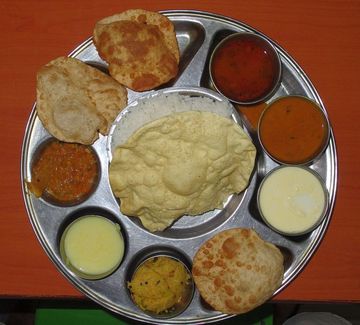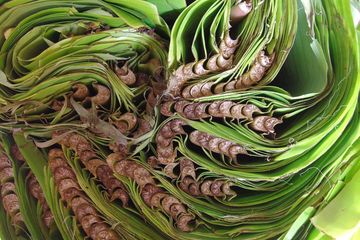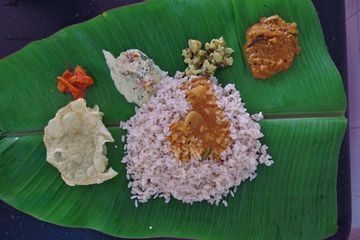South Indian Thalis
(thomas;2015-May-21)
 Thalis are quintessentially Indian dishes. In its most basic form, a thali gives you rice and/or chapatis plus a few curries, all served on a metal platter. Normally you'll also get a crispy papadum. In the old days, you could always ask for more rice and curry but these days things are changing: there are now “limited” thalis, ie one plate with some rice and perhaps two or three chapatis and the curries, but that's it. It is still possible to find unlimited thalis but it is not as straightforward as it used to be. Thalis also come in veg and non-veg varieties. We tend to stick with veg thalis: they are cheaper and often fresher. (We occasionally eat meat dishes in India but we tend to stick to freshly grilled Tandoori chicken.)
Thalis are quintessentially Indian dishes. In its most basic form, a thali gives you rice and/or chapatis plus a few curries, all served on a metal platter. Normally you'll also get a crispy papadum. In the old days, you could always ask for more rice and curry but these days things are changing: there are now “limited” thalis, ie one plate with some rice and perhaps two or three chapatis and the curries, but that's it. It is still possible to find unlimited thalis but it is not as straightforward as it used to be. Thalis also come in veg and non-veg varieties. We tend to stick with veg thalis: they are cheaper and often fresher. (We occasionally eat meat dishes in India but we tend to stick to freshly grilled Tandoori chicken.)
Many Indian states have their own thali varieties, so you can find Gujarati, Punjabi or Rajasthani thalis. In southern India thalis mostly boil down to the so-called “South Indian Thali” and they are often served on a banana leaf. (These days you can find thalis on banana leaves even in top-flight restaurants… in an attempt to sell Western tourists “authenticity”.)
South Indian thalis are similar to what one would get in the north, but there are some differences. First, there's almost always some curd included. Second, in all but the cheapest eateries, you will get something sweet, ie a cup of sweet rice with cinnamon or a coarse semolina concoction. Perhaps the biggest difference is in the number of curries: in the south, there are always two basic dishes called sambar (a broth made with lentils) and rasam (a thin, tamarind-based soup). Over and above these two there is a number of curries (four or five, sometimes even seven or eight): some dry, some wet. These are made from anything found in the local market: pumpkin, potato, peas, paneer (Indian cheese), cauliflower, carrots, spinach… often in a colourful mixture. Some of the curries are mild (often cooked with coconut milk and/or ginger), others are rather fiery. Often, there are also two big cups on the table: one with buttermilk, the other with spicy red lime pickle.
In the south, you normally get as much rice and sambar as you want, but many restaurants are quite careful with the curries. The Indians eat their thalis with the fingers: they mix some of the sambar and curry with the rice, perhaps topping that with a little buttermilk, and then form a ball and balance this into their mouths. We normally use spoons… though in some of the more basic eateries they simply have no Western-style cutlery.
The picture above left shows a typical south Indian thali. In the centre, there's a heap of rice and the papadum; there are also three chapatis. In the small dishes on the right side there is rasam (top), sambar and curd. In the other three dishes we find a lentil curry, a coconut-based curry and the sweet bit. The other thali, on the banana leaf, is much simpler, just some sambar on top of the rice and a few curries. If you look closely you can see that the rice looks a bit pinkish: some eateries offer two varieties of rice, the cheaper Basmati-style rice (white) and the slightly more expensive red rice (not really red). In this case, the Basmati thali was 50 Rs (slightly more than 50 pence) and the red rice thali was 55 Rs.
 The banana leaf thali doesn't perhaps look as appetising as the other one, in the top left corner, but it was absolutely delicious, not least because the waiter was supplying more curry all the time. The secrets of a really good thali are the freshness of the ingredients and the spice mix used.
The banana leaf thali doesn't perhaps look as appetising as the other one, in the top left corner, but it was absolutely delicious, not least because the waiter was supplying more curry all the time. The secrets of a really good thali are the freshness of the ingredients and the spice mix used.
One strange thing about south Indian thalis is that you can only get them for lunch (ie between 12pm and 3 or 4pm). In the north, thalis are available all day and into the night. In the south, evening meals are just snacks: idlis (steamed spongy rice cakes), dosas (thin, cripsy rice crepes) and vadas (fried lentil doughnuts). These are served with a sambar-like broth and a coconut chutney and always eaten with the fingers.
Want to read more? Go back to A Visit to Chennai's High Court or go on to Old Habits Die Hard or go up to Blog
$ updated from: Blog.htxt Mon 28 Apr 2025 14:55:29 trvl2 — Copyright © 2025 Vero and Thomas Lauer unless otherwise stated | All rights reserved $



